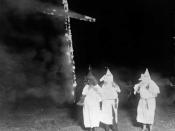Although the Immigration Act of 1924 was mainly the unfortunate result of discriminatory racial theories of nativism and antiforeignism, other factors influenced also Congress to pass the restrictive act, including the rising Red Scare and the spread of the new Ku Klux Klan.
The largest factor in the Congressional passing of the Immigration Act of 1920 was the fundamental American belief that ÃÂnativeÃÂ Americans were superior to foreigners, including the 800,000 immigrants who flooded the country in 1920-1921. About two-thirds of them were from southern and eastern Europe. The ÃÂone-hundred-percent Americans,ÃÂ recoiling at the sight of this resumed ÃÂNew Immigration,ÃÂ were disgusted at the influx of sickly Europeans. Senator Ellison D. Smith expressed his nativist concerns in his 1924 Congressional Record by stating, ÃÂI think we now have sufficient population in our country for us to shut the door and to breed up a pure, unadulterated [Anglo-Saxon] American citizenshipÃÂ It is for the preservation of that splendid stockÃÂ that I would make this not an asylum for the oppressed of all countries.ÃÂ
Congress temporarily plugged the breach with the Emergency Quota Act of 1921, which restricted European immigration in any given year to a definite quota of 3 percent of the people of their nationality who had been living in the United States in 1910. However, this national-origins system was relatively favorable to the immigrants from southern and eastern Europe, for by 1910 immense numbers of them had already arrived. According to the United States Bureau of the Census, southern and eastern European immigration reached 1,250,000 in 1905 and a considerable 700,000 in 1910.
Thus, the Emergency Quota Act of 1921 was replaced by the Immigration Act of 1924. The United States Bureau of Immigration explained in its Annual Report of the Commission-General Immigration of 1924 that ÃÂthe...


